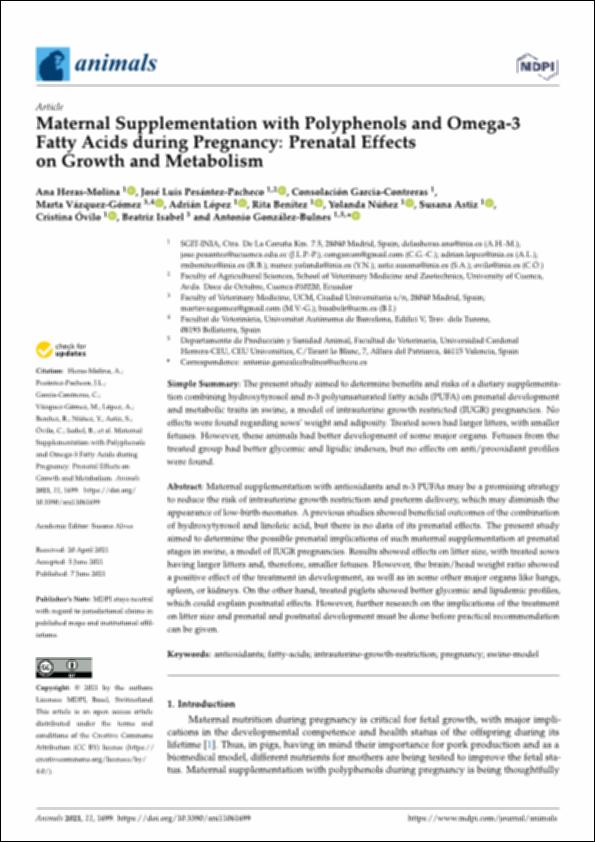Please use this identifier to cite or link to this item:
http://hdl.handle.net/10637/13555Maternal supplementation with polyphenols and omega-3 fatty acids during pregnancy : prenatal effects on growth and metabolism
| Title: | Maternal supplementation with polyphenols and omega-3 fatty acids during pregnancy : prenatal effects on growth and metabolism |
| Authors : | Heras Molina, Ana Pesántez Pacheco, José Luis García Contreras, Consolación Vázquez Gómez, Marta López García, Adrián Benítez Yañez, Rita González de Bulnes López, Antonio |
| Keywords: | Gestación.; Aminoácidos en nutrición animal.; Fatty acids.; Pregnancy.; Cerdos - Cría y explotación.; Ácidos grasos.; Swine - Breeding.; Antioxidantes.; Antioxidants.; Amino acids in animal nutrition. |
| Publisher: | MDPI |
| Citation: | Heras-Molina, A., Pesántez-Pacheco, J. L., Garcia-Contreras, C., Vázquez-Gómez, M., López, A., Benítez, R., Núñez, Y., Astiz, S., Óvilo, C., Isabel, B. & González-Bulnes, A. (2021). Maternal supplementation with Polyphenols and Omega-3 Fatty Acids during pregnancy: prenatal effects on growth and metabolism. Animals, vol. 11, i. 6 (07 jun.), art. 1699. DOI: https://doi.org/10.3390/ani11061699 |
| Abstract: | Maternal supplementation with antioxidants and n-3 PUFAs may be a promising strategy to reduce the risk of intrauterine growth restriction and preterm delivery, which may diminish the appearance of low-birth-neonates. A previous studies showed beneficial outcomes of the combination of hydroxytyrosol and linoleic acid, but there is no data of its prenatal effects. The present study aimed to determine the possible prenatal implications of such maternal supplementation at prenatal stages in swine, a model of IUGR pregnancies. Results showed effects on litter size, with treated sows having larger litters and, therefore, smaller fetuses. However, the brain/head weight ratio showed a positive effect of the treatment in development, as well as in some other major organs like lungs, spleen, or kidneys. On the other hand, treated piglets showed better glycemic and lipidemic profiles, which could explain postnatal effects. However, further research on the implications of the treatment on litter size and prenatal and postnatal development must be done before practical recommendation can be given. |
| Description: | Este artículo se encuentra disponible en la siguiente URL: https://www.mdpi.com/2076-2615/11/6/1699 Este artículo pertenece al número especial "Current Challenges and Targets for the Reproductive Management of Farm Animals". En este artículo de investigación también participan: Yolanda Núñez, Susana Astiz, Cristina Óvilo y Beatriz Isabel. |
| URI: | http://hdl.handle.net/10637/13555 |
| Rights : | http://creativecommons.org/licenses/by/4.0/deed.es |
| ISSN: | 2076-2615 (Electrónico) |
| Issue Date: | 7-Jun-2021 |
| Center : | Universidad Cardenal Herrera-CEU |
| Appears in Collections: | Dpto. Producción y Sanidad Animal, Salud Pública Veterinaria y Ciencia y Tecnología de los Alimentos |
Items in DSpace are protected by copyright, with all rights reserved, unless otherwise indicated.


